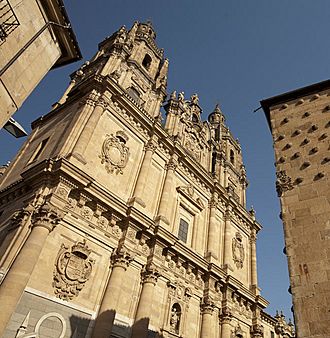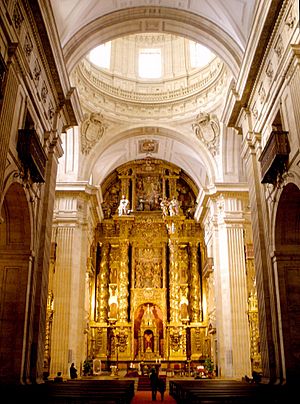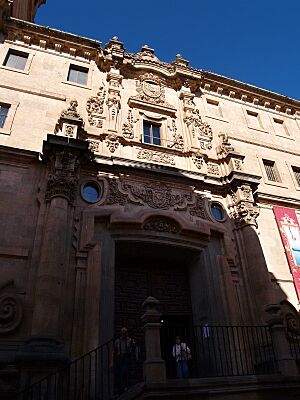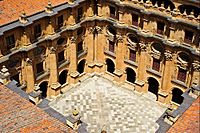La Clerecía, Salamanca facts for kids
Quick facts for kids La Clerecía |
|
|---|---|
 |
|
| General information | |
| Architectural style | Baroque |
| Location | Castile and León |
| Town or city | Salamanca |
| Country | Spain |
| Coordinates | 40°57′46″N 5°39′58″W / 40.9628°N 5.6662°W |
| Completed | 1617 |
| Owner | Pontifical University of Salamanca |
| Design and construction | |
| Developer | Society of Jesus |
| UNESCO World Heritage Site | |
| Criteria | I, II, IV |
La Clerecía is a famous and beautiful building in Salamanca, Spain. It was built a long time ago, between the 17th and 18th centuries. This amazing building has a special style called Baroque. It used to be a school for the Society of Jesus, a group of Catholic priests.
The building has two main parts. One part is the college, which includes an interesting cloister (a covered walkway around a courtyard). The other part is the church, which has a very impressive front, called a facade. The name "Clerecía" came later, after the Jesuits left Spain. It refers to its connection with the Royal Clergy of San Marcos.
Contents
History of La Clerecía
Construction of La Clerecía started in 1617. It was supported by Margaret of Austria, who was the wife of King Philip III. The building was finally finished in 1754.
The overall design of the building was created by Juan Gómez de Mora.
Later, in 1767, King Charles III ordered the Jesuits to leave Spain. After this, the building was given to the Royal Clergy of San Marcos. This group later gave most of the building to the Diocese of Salamanca. The Diocese then used it as a seminary, a school for training priests.
In 1940, the Pontifical University of Salamanca was created by Pope Pius XII. The Diocese gave the building to this new university to be its main home. Even though the church part was not originally included, the university started using it for tourism in 2012. Now, only weddings for people connected to the university are held there.
Art and Architecture of La Clerecía
The Church's Grand Facade

The church has a very grand front, or façade, with three main sections.
The first section has large columns that look like they are part of the wall. These columns guard the three entrance doors. Above the side doors, you can see coats of arms from Spain. Above the central door, there is a special spot with a statue of Saint Ignatius of Loyola. After the Jesuits left, a stone lion was added at the statue's feet. This made the statue look like Saint Mark instead.
The second section has two oval shapes with fancy Baroque decorations on the sides. In the middle, there is a large window. The first two sections were designed by a Jesuit architect named Father Mato.
The third section was designed by Andrés García de Quiñones. He built the tall towers. He also created the central bell tower, which has a carving showing the Holy Spirit arriving. There are also sculptures of the Virgin Mary and the founding kings.
Inside the Church
The inside of the church has one main long area, called a nave. There are chapels (small rooms for prayer) between strong supports called buttresses. This design is similar to the Jesuit church of Il Gesú in Rome. The church has four main sections and a wide area that crosses the main nave.
The main part of the church is lit by a large dome. This dome is also the work of Father Mato. It is very tall, reaching 50 meters, the same height as the church's nave. It had to be strengthened many times because of its huge size.
The ceilings of the nave are curved and decorated with stucco.
The Main Altarpiece
The main altarpiece is a large, decorated screen behind the main altar. It was made by Juan Fernández in 1673, with sculptures by Juan Rodríguez.
The altarpiece has three vertical sections and three horizontal levels. Four large, twisted columns decorated with grapes separate the sections. In the first two levels, you can see statues of important church leaders like Saint Gregory, Saint Ambrose, Saint Augustine, and Saint Jerome. In the middle, there is a large display inspired by the church's dome. It also has a carving showing the Pentecost story.
In the top level, there is a carving of Saint Ignatius writing his "Spiritual Exercises." He is shown being inspired by the Virgin Mary, with the Trinity present. On the sides, you can see the coats of arms of King Philip III and Queen Margaret of Austria. There are also sculptures of the four evangelists. The gold decoration on the altarpiece was finished in 1760.
The Sacristy
The sacristy is a rectangular room located behind the main altar. It is as wide as the church's main nave. Its ceiling is a curved barrel vault with five sections decorated with paintings.
At the front of the sacristy, there is a special niche altarpiece. It has mirrored panels and looks like a triumphal arch. Angels on carved rocks show symbols of the Passion of Christ. Above, there is an ivory crucifix with angels. This altarpiece was made to hold a statue of Jesus being whipped. The mirrors were designed to show the wounds on his back. This statue was created by Luis Salvador Carmona.
When the sacristy became a classroom for the Pontifical University, the statue was moved to one of the church's side chapels.
The Courtyard of the Studios
This courtyard was also designed by Andrés García de Quiñones. It looks more like a royal palace courtyard than a religious building's cloister. The first two levels have columns with arches on the ground floor and balconies with round windows on the first floor. You can reach these from the street and the church. The third floor has more balconies between flat columns.
The main floor of the cloister is decorated with 28 large canvas paintings. These paintings tell the story of Saint Ignatius's life, from the battle of Pamplona until his death. The Society of Jesus ordered these paintings from an artist named Sebastiano Conca.
Institutions at La Clerecía
Pontifical University of Salamanca
The Pontifical University of Salamanca is a private university. It was founded in 1940.
Religious Groups and Brotherhoods
Several religious groups, called Penitential Brotherhoods, have their main meeting places in the church of La Clerecía. These groups take part in the Holy Week celebrations in Salamanca.
- The "Hermandad Universitaria del Santísimo Cristo de la Luz y Nuestra Señora Madre de la Sabiduría" was founded in 1948.
- The "Hermandad de N.P. Jesús Flagelado y Nuestra Señora de las Lágrimas" was founded in 1948, but its history goes back to 1913.
See also
 In Spanish: La Clerecía (Salamanca) para niños
In Spanish: La Clerecía (Salamanca) para niños



